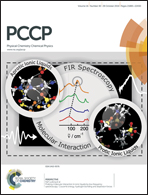Low frequency vibrational dynamics and polyamorphism in Y2O3–Al2O3 glasses
Abstract
Glass formation, and associated potential polyamorphism are investigated for the key ceramic Y2O3–Al2O3 using a combination of experimental and theoretical techniques. Liquid samples are rapidly cooled by drop quenching and high and low density amorphous regions (LDA and HDA respectively) are identified using reflected light microscopy. Raman spectra are obtained to low frequency focussed on regions identified as pure LDA or HDA. The respective compositions of these regions are confirmed by electron microprobe analysis. These spectra are used to extract the vibrational densities of states and these are compared with those generated for the liquid oxide using polarizable-ion molecular dynamics simulations. The experimental and simulated spectra are used to determine the low temperature heat capacities. The low frequency regions of the spectra display an excess of states (boson peaks) which are different for the two glasses. Thermodynamic modelling is used to demonstrate how samples of the same composition my vitrify or not depending upon the quench rate.


 Please wait while we load your content...
Please wait while we load your content...